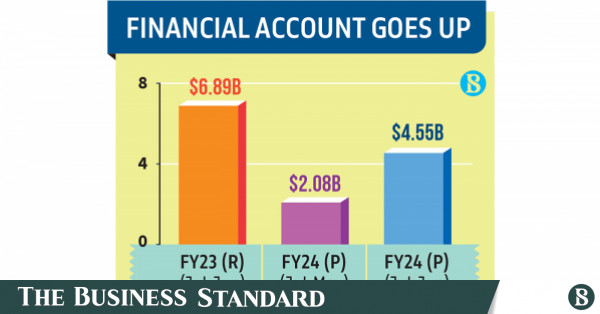Foreign loan inflows raise $2.5b financial account surplus in June


Y-o-y deficit in balance of payments falls by nearly $5 billion in FY24
Infograph: TBS
“>
Infograph: TBS
The country’s financial account surplus surged by nearly $2.5 billion in June, the final month of the fiscal 2023-24, primarily driven by inflows of bilateral and multilateral loans.
According to data from the central bank, the financial account surplus reached $4.55 billion at the end of FY24, up from just over $2 billion at the end of May. However, the surplus amount decreased slightly compared to FY23, when the financial account had a surplus of approximately $7 billion.
The financial account balance is the primary source of a country’s foreign payments. When a country’s current account balance turns negative, it makes foreign payments from the financial account. If the financial account becomes negative, then payments are made directly from reserves.
In FY24, the country’s trade deficit in the balance of payments decreased by nearly $5 billion compared to the previous fiscal year. Similarly, the current account deficit also declined by roughly the same amount compared to FY23.
Central bank data shows that the increase in medium and long-term loans significantly contributed to the rise in the financial account surplus. In FY24, medium and long-term loans amounted to $9.68 billion, which is about 11% higher than in the previous fiscal year.
A senior official from the central bank said the inflow of foreign loans was even better a few years ago, but the rollover of short-term loans has decreased. Due to factors like rising interest rates on the dollar in the international market and exchange rate risks, borrowers have become less interested in taking new loans, he said.
“Instead, they are more focused on repaying existing loans. Additionally, the decline in imports has also contributed to the reduction in loan demand,” he said.
Professor Mustafizur Rahman, a distinguished fellow of the Centre for Policy Dialogue, told The Business Standard, “Receiving bilateral and multilateral loans, including budgetary support loans, in June has helped increase the financial account surplus. However, it is important to keep in mind that these loans are creating payment obligations for the future.”
Trade deficit drops 18%
Due to various measures taken by the central bank, imports have significantly decreased, leading to an 18% reduction in the country’s trade deficit in FY24 compared to FY23, despite the lack of export growth. As a result, the trade deficit stood at $22.43 billion.
The trade balance is the difference between a country’s export and import amounts.
According to the central bank data, the country’s import expenditure in FY24 amounted to $63.24 billion, while export earnings were $40.81 billion. Both imports and exports decreased in FY24 compared to the previous year.
Another senior official from the central bank said import payments in FY24 decreased due to the Bangladesh Bank’s efforts to control imports. Additionally, throughout the year, banks faced a shortage of dollars, which prevented businesses from opening letters of credit (LCs) for imports as needed, he said.
However, there has also been a slight decrease in the demand for opening import LCs from the businesses’ side, he added.
Infograph: TBS
“>
Infograph: TBS
Current account deficit narrows
In FY24, remittances increased by $2 billion compared to the previous fiscal year. Along with a reduction in the trade deficit, this has led to a nearly 44% decrease in the current account deficit, which now stands at $6.51 billion.
The current account, encompassing the balance of trade (exports minus imports of goods), net income from abroad, and net current transfers, holds significant importance as a key component of the broader balance of payments.
Professor Mustafizur Rahman said, “A decrease in the current account deficit indicates some improvement in our balance of payments situation. However, we have not yet reached a comfortable position.”
The economist added, “Once we had a current account surplus, and before returning to that stage, it is important not to allow imports to increase excessively.”
According to the central bank data, the error and omission, known as the unaccounted balance, stood at $2.89 billion at the end of FY24. It represents a decrease of over $1 billion compared to the previous fiscal year.
“Error and omission figures were not as high a few years ago. We need to investigate why these figures have become so large and whether there is a reasonable explanation behind this increase,” said Prof Mustafiz.
The central bank has reported that the overall balance of payments deficit at the end of FY24 decreased by about 48% compared to FY23, standing at $4.3 billion. Typically, the overall balance of payments deficit is paid from the country’s foreign exchange reserves. As a result, according to BPM6 guidelines, the country’s foreign exchange reserves decreased by over $3 billion in the past year.
The CPD distinguished fellow said although pressure on the reserves has slightly eased, it still persists.
He emphasised the need to focus on increasing remittances by curbing hundi and boosting exports of goods and services.
“In the short term, maintaining normal transport of goods both locally and internationally is crucial, while in the medium term, efforts should be directed towards enhancing business productivity and reducing the cost of doing business,” said Prof Mustafiz.
The economist also highlighted the importance of speeding up the implementation of development projects and releasing foreign loans in the pipeline to bolster reserves and ensure exchange rate stability.




